

“Our Lenten Journey: The Way of Sorrows”
Matthew 27:27-33
Pastor Kevin Vogts
Trinity Lutheran Church
Paola, Kansas
Lent Service IV—March 23, 2022
In the Name of the Father and of the Son and of the Holy
Spirit. Amen.
The theme for our Wednesday sermons during Lent this year is “Our
Lenten Journey,” looking at the locations of Christ’s final sufferings and
death. So far we have contemplated “The Upper Room,” “The Garden of
Gethsemane,” and “The Judgment Hall.” This evening we continue with “The
Way of Sorrows.”
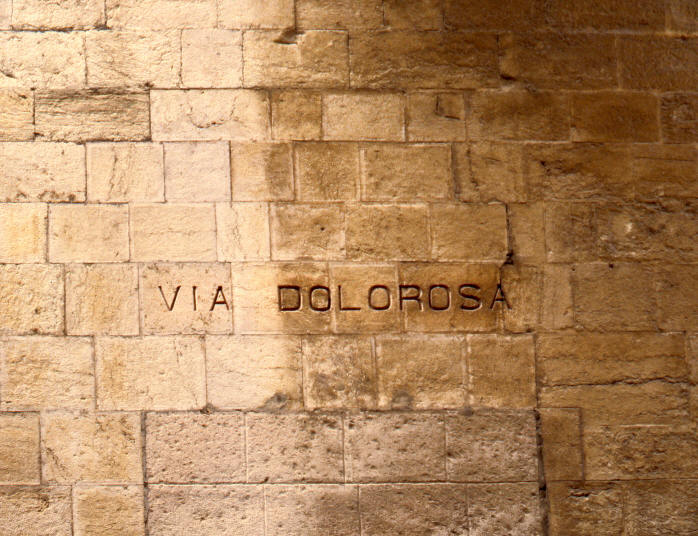
There is a street in Jerusalem known as the “Via Dolorosa,” Latin for
“The Way of Sorrows.” Matthew reports: “Then the governor’s soldiers took
Jesus into the Praetorium and gathered the whole company of soldiers around him.
They stripped him and put a scarlet robe on him, and then twisted together a
crown of thorns and set it on his head. They put a staff in his right hand and
knelt in front of him and mocked him. ‘Hail, king of the Jews!’ they said. They
spit on him, and took the staff and struck him on the head again and again.
After they had mocked him, they took off the robe and put his own clothes on
him. Then they led him away to crucify him. As they were going out, they met a
man from Cyrene, named Simon, and they forced him to carry the cross. They came
to a place called Golgotha, which means The Place of the Skull.”
The “Via Dolorosa” in Jerusalem is the traditional route on which
Christ was forced to carry his cross from “The Judgment Hall” to “Mt. Calvary.”
It is a narrow street with rough, cobblestone paving. In length it is just
a few city blocks. But for our Savior, this short journey was indeed “The
Way of Sorrows.”
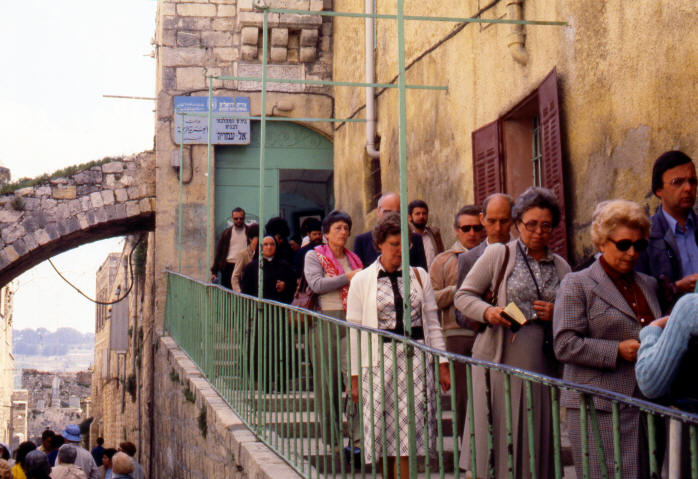
Every Friday, thousands of Christian pilgrims from all over the world
gather in Jerusalem to walk “The Way of Sorrows.”
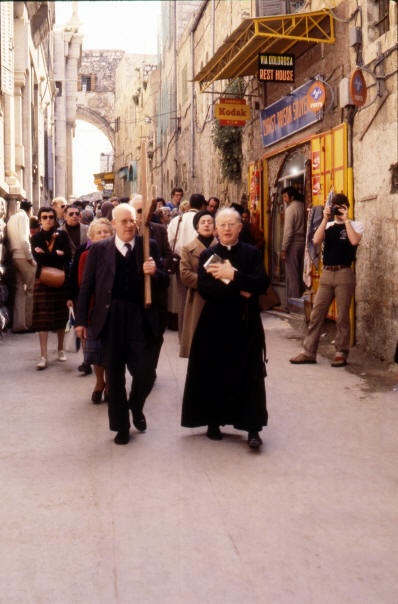
And Good Friday each year, tens of thousands throng this street in a
very moving remembrance of Christ’s journey on the first Good Friday.
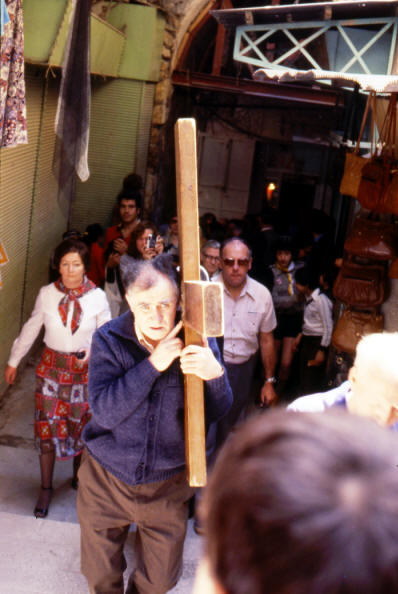
Almost all of these pilgrims walking the Via Dolorosa carry with them a
cross, often a small jewelry cross that they will wear the rest of their lives,
or a larger cross that they will hang in their homes. Some of the pilgrims
carry life-sized crosses to reenact Christ’s journey on the Via Dolorosa.
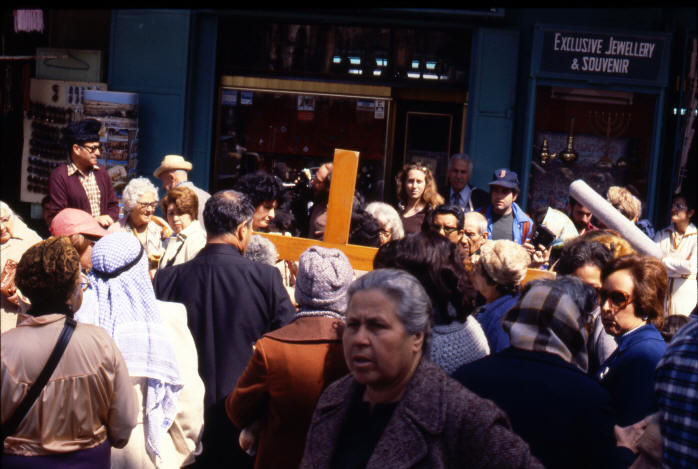
One of the most memorable events in my life was being in Jerusalem for
Holy Week in 1980, and walking the “Via Dolorosa” on Good Friday. That’s
when I took all the pictures being used tonight. And I bought this
handmade Lenten stole that I’m wearing on that Good Friday in a little shop
along the “Via Dolorosa.”
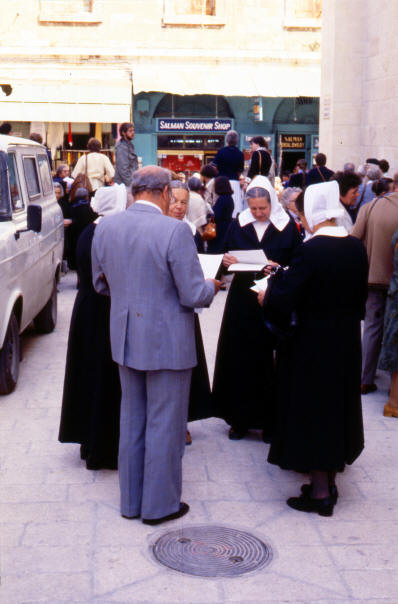
Along the way the pilgrims gather in groups for devotions. This
is a group of Lutheran deaconesses from Germany.
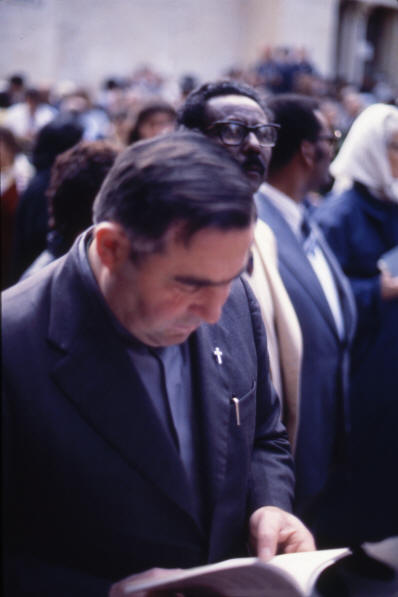
People pray and sing as they retrace the steps of Christ out to
Calvary.
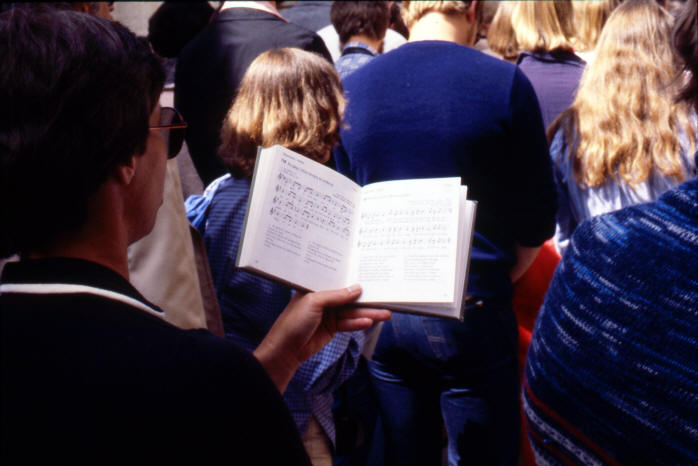
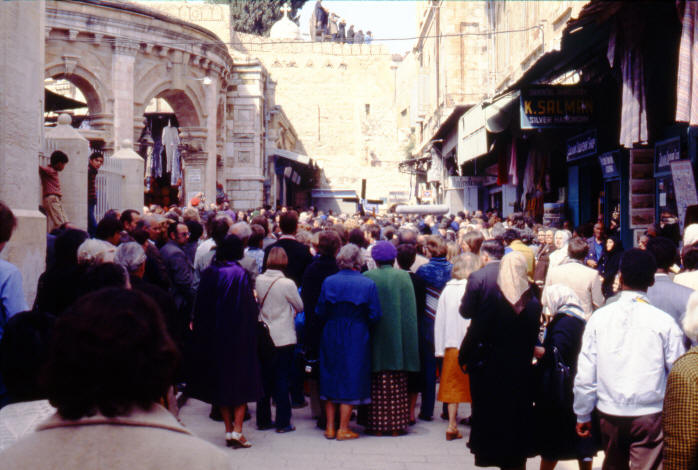
The pilgrimage on The Way of Sorrows ends at the Church of the Holy
Sepulcher, built some 1,700 years ago over the traditional sites of Calvary and
the empty tomb.
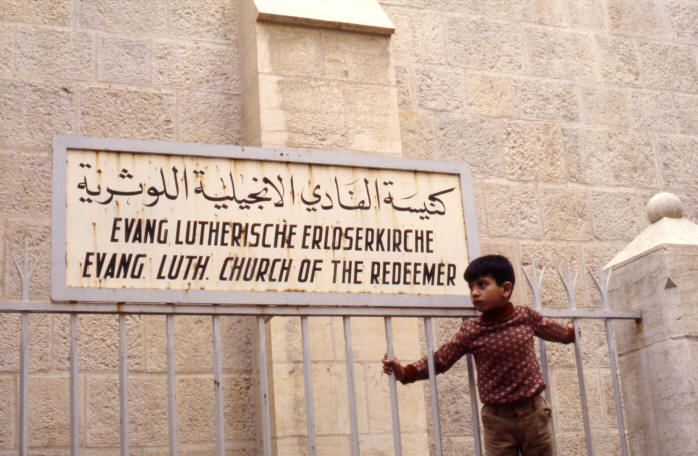
Directly across the street from the Church of the Holy Sepulcheris the
German Lutheran Church of the Redeemer, built in the 1800’s.
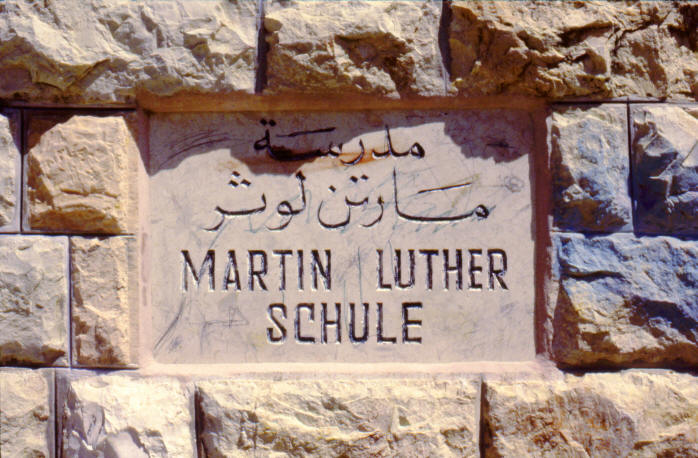
And also a parochial school, the “Martin Luther Schule.”
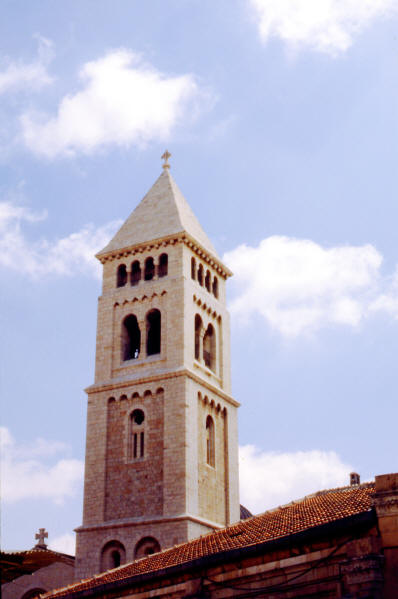
The tower of this Lutheran Church is the highest point in all the Old
City of Jerusalem.

You can climb to the top of this tower and from there get a good view
looking down upon the Church of the Holy Sepulcher. Many archaeologists
now believe this ancient church really was built over the authentic sites of
Calvary and the garden tomb.
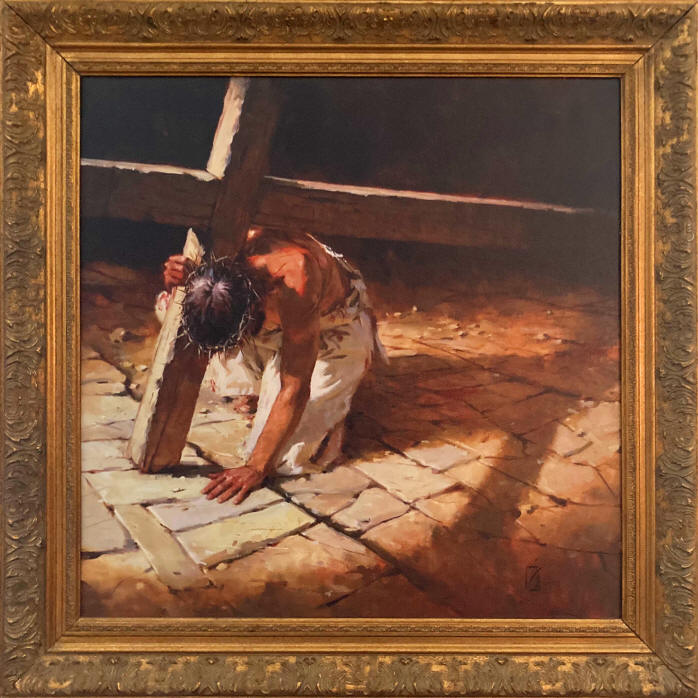
This moving modern portrait of Christ bearing his cross on the Via
Dolorosa adorns our Heritage Room here at Trinity.
Christ’s journey on “The Way of Sorrows” is described by Dr. Paul
Maier, a Lutheran pastor and professor of history at Western Michigan State
University. By the way, he is also the son of the famous “Lutheran Hour”
speaker, Dr. Walter A. Maier:
“[Crucifixion was certainly the most public form of execution.]
From the moment the judgment went against him, the condemned victim was on
display: he had to shoulder his [cross], and carry it in a hideously public
parade out to the place of execution . . . as a public example and warning to
others to avoid his crime, which was plainly stated [on] a placard [which was
carried before him and then] posted above his head [on the cross]. . .
“The route Jesus was forced to take on his final journey to the cross
came to be called, long ago, [the “Via Dolorosa” or “The Way of Sorrows.”]
A centurion, dressed in a Roman uniform, preceded him . . . Four soldiers
formed the execution detail itself, but probably all of the 600 [soldiers] in
Pilate’s Jerusalem [force] were lining the roadsides to control any
demonstrations. . . Evidently a great crowd of people, including numerous women,
bewailed and lamented his fate. By now news of Jesus’ arrest and
condemnation was spreading through Jerusalem, but too late for his followers to
try to save him . . . people . . . were rushing to the roadside in tears .
. .
“Two other condemned men were also grunting under their [crosses] on
the way out to Golgatha . . . Jesus’ scourging must have been more brutal
. . . than theirs, because he stumbled and collapsed under his [cross], and the
troops had to impress a bystander . . . into carrying the [cross] for him.
“When they reached Golgatha . . . the execution detail stripped
off his clothes . . . divided his garments into four shares . . . [and] cast
lots for his cloak . . .
“Jesus’ hands or wrists were nailed to the [cross] . . . and his feet
were spiked onto it.”*
Isaiah says, “He was despised and rejected by men, a man of sorrows,
and familiar with suffering. . . Surely he took up our infirmities and carried
our sorrows. We observed him stricken by God, smitten by him, and
afflicted. he was pierced for our transgressions, he was crushed for our
iniquities; the punishment that brought us peace was upon him, and by his wounds
we are healed. We all, like sheep, have gone astray, each of us has turned
to his own way; and the Lord has laid on him the iniquity of us all. . .
he was led like a lamb to the slaughter . . .”
Christ endured the torturous march from “The Judgment Hall” to “Mt.
Calvary” for you. As Hebrews says, “we have been made holy through the
sacrifice of the body of Jesus Christ once for all.” “The Lord has on him
the iniquity of us all.” On account the suffering he endured as your
substitute, your sins are all forgiven.
And there is another comforting message for you in Christ’s agony on
the “Via Dolorsa.” Isaiah says he was “a man of sorrows, and familiar with
suffering.” You know how your life in this world is so often your own,
personal “Via Dolorsa,” a way of sorrows, and God knows it too. Your God
understands your pain, because your God came down to earth and was made man, and
your God himself endured the ultimate way of sorrows. Compressed into his
horrible journey to Mt. Calvary were all the pains, all the sufferings, all the
sorrows of all humanity.
Hebrews says that Jesus is able to “sympathize with us in our
weaknesses” because he himself was “tested in every way, just as we are.”
A few decades ago there was a president who famously tried to connect with the
common people by saying, “I feel your pain.” Your God is not some distant,
nebulous Higher Power. For, with him it wasn’t just a slogan—your God really
did feel your pain, as he carried his cross out to Calvary. Paul says in Romans, “If God is for us, who can be against us.”
What a comfort to know that in all your struggles, as you face your own personal
“Via Dolorosa,” your own way of sorrows in this life, God is on your side, he
sympathizes, he understands, he feels your pain. As Isaiah says, “In all
their distress he too was distressed.” That is the message of “The Way of
Sorrows.”
Amen.
*In the Fullness of Time, p. 164ff
Return to Top | Return to Sermons | Home | Email Church Office